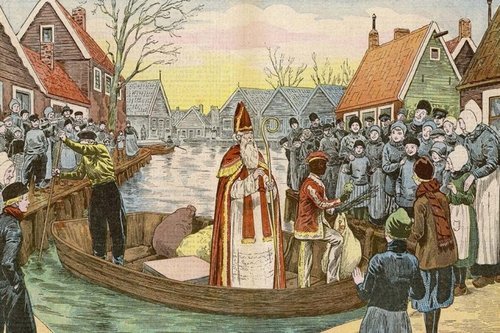


12/06/2013
Just because your country doesn’t celebrate December 25th doesn’t mean you can’t have your very own War on Christmas. In the New York Times, a black Dutch writer says:
Why the Dutch Love Black PeteWHEN I was growing up in Amsterdam in the 1970s, the phenomenon of Santa Claus was relatively unknown. Christmas was celebrated without Santa and mostly without gifts. St. Nicholas — Sinterklaas in Dutch — was the man with the presents.

If one had the good fortune to be Jewish, one received presents not only on Dec. 5, the eve of Sinterklaas’s name day, but also at Hanukkah. Only in recent years has Santa Claus, who comes on Dec. 25, made his rise to stardom in Holland, and today a Dutch child — or a Dutch adult for that matter — no longer has to be Jewish to cash in twice in December.
Sinterklaas arrives from Spain by steamboat in late November, travels farther on horseback, climbs onto roofs and on Dec. 5, known as “Pakjesavond,” drops presents through the chimney with the help of the Black Petes, a crew of dark-skinned helpers wearing large earrings who cavort and entertain and, as Dutch parents often tell their children, owe their blackness to chimney soot. …
Until recently, Black Pete was uncontroversial. Not because the Dutch are particularly racist, but because Sinterklaas, like the royal family, is sacred in the Netherlands, perhaps because of a dearth of other, specifically Dutch traditions. A matter, in other words, of conservatism.
Such traditions are even more important today, given the view that, in order to safeguard the Dutch national identity, homegrown culture and folklore must not be tampered with — a view expressed primarily, though not exclusively, by the extreme right wing Party for Freedom, run by Geert Wilders.
But just as the defense of traditions has grown stronger, so has the criticism that Black Pete is a racist holdover from the Netherlands’s colonial past. In January the United Nations High Commission for Human Rights sent a letter to the Dutch government stating that Black Pete perpetuated the image of people of African descent as second-class citizens and constituted a “living trace of past slavery.”
The Dutch government responded by saying that it regarded the Sinterklaas tradition as a children’s celebration, that it was aware of the differences of opinion concerning Black Pete, but that it was highly committed to combating discrimination in all forms.
… Yet the general tenor among the Dutch public was that “they” should keep their mitts off “our tradition,” an opinion you can hear in any number of variations on any street corner. By “them” people mean the United Nations and “unnatural” Dutch citizens, by both birth and naturalization, who want to put an end to this admittedly dubious tradition.
The Black Pete debate underscores how deep within the Netherlands’s prosperous and safe society lies the fear of losing identity, undoubtedly fueled by globalization, migration and the notion that the European Union is gradually doing away with the European nation state.
… The truly disturbing thing is the aggression conjured up by this public debate, the thinly disguised xenophobia that roiled to the surface when attempts were made to make Black Pete less black. A civilized person, after all, could say: “Personally, I don’t have much of a problem with Black Pete, but if others do, well, then, why don’t we make him Green Pete or Blue Pete?”
But no. To my utter amazement, at least two million Dutch people have taken the stance: “Black Pete, c’est moi.”
Which once again goes to prove that national identity often boils down to distasteful folklore.
Arnon Grunberg is the author of the novels “The Jewish Messiah” and “Tirza.” This essay was translated by Sam Garrett from the Dutch.
Oh, sorry, check that. It turns out that the NYT did not find a black writer to be offended on behalf of blacks over this burning issue of international importance.
My apologies.